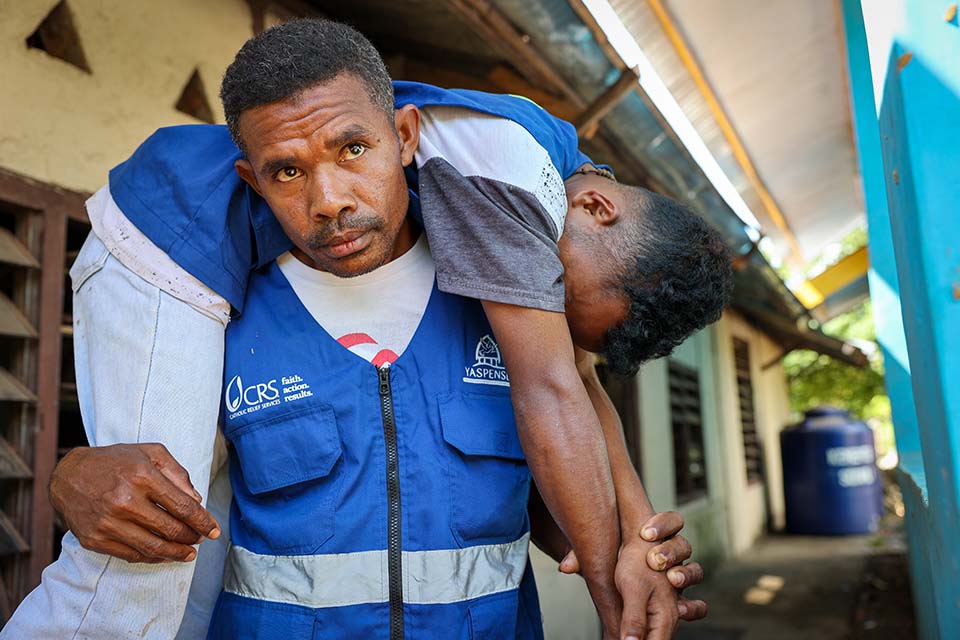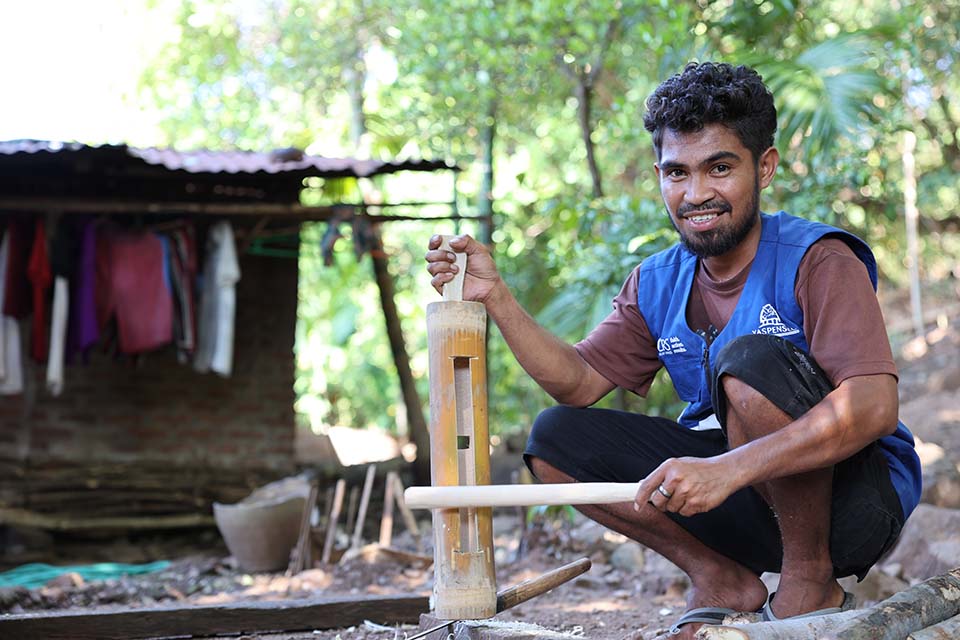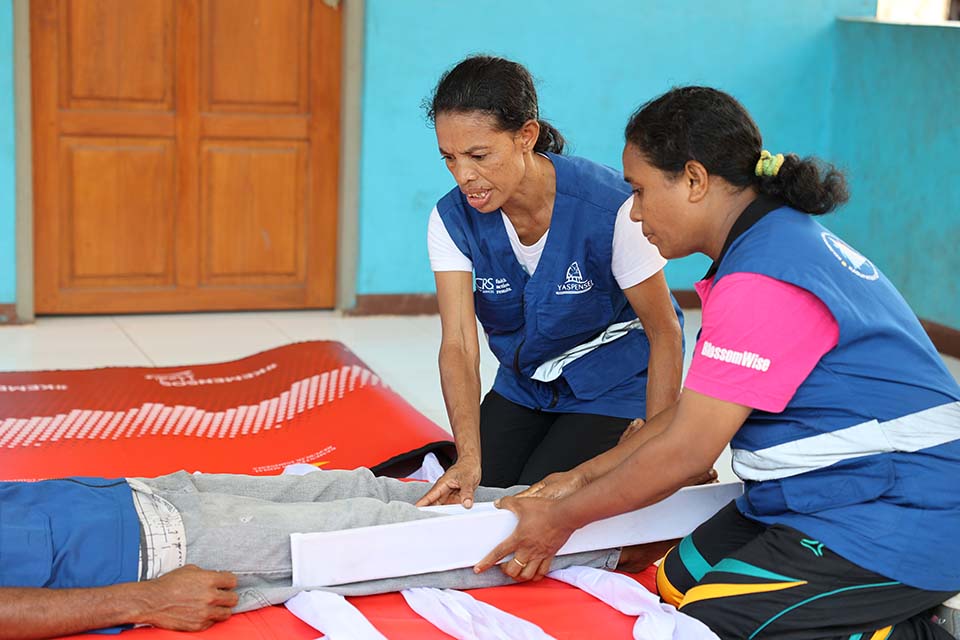

Improving Emergency Preparedness in Indonesia
In the region called the Ring of Fire—located around the rim of the Pacific Ocean—disaster risk reduction is taken very seriously.
This region of Indonesia experiences earthquakes, volcanic eruptions and extreme weather, including cyclones. Flores Island has seen it all.

As part of the FLODESA project, a total of 10 village disaster preparedness groups ensure communities know how to respond during natural disasters and are connected to local disaster management systems.
Photo by Benny Manser/CRS
In 1992, a devastating earthquake and subsequent tsunami killed at least 2,500 people and left 90,000 people homeless. Following the tsunami, families rebuilt their homes on higher ground.
In December 2021, communities in Flores Island were struck by a 7.4 magnitude earthquake. Evita Tiro Wada, a farmer and mother of four children, was in her kitchen at the time.
“It was the morning, and I was cooking,” Evita says. “My oldest daughter screamed at me to get out of the house. I quickly took the food off the stove and ran to higher ground with her to avoid a possible tsunami. We stayed at the higher ground with others and followed instructions from the village. We were worried as our home is in a low coastal area very close to the sea. We were told to stay for four days at higher ground with relatives.”
Mobilizing for risk reduction
As part of the Flores Disaster Risk Reduction to Enhance Sustainable Livelihoods project, Catholic Relief Services worked in 10 villages—with 286 residents in total—to form disaster preparedness groups. These groups help increase risk reduction skills and knowledge, ensuring communities are prepared and connected to disaster management systems, including a responsive local government.

By using bamboo and other locally available materials, an early warning system has been developed. One component of the system is a bamboo alarm to alert communities to quickly evacuate in an emergency.
Photo by Benny Manser/CRS
Groups developed an early warning system using locally available bamboo. One component of the system alerts communities to quickly evacuate in an emergency.
The bamboo alarm is sounded after village authorities receive notice of an emergency from an official source, such as the Meteorology and Climatology and Geophysics Agency.
The groups are also working with communities as they improve their disaster mitigation, preparedness and management efforts.
"I learned how to provide early warnings to communities and to give advice to the community to evacuate from low land to high ground,” Evita says. “Also one of the first activities I was involved in was cleaning waste materials from the river and streams. The waste was blocking bridges which caused water to rise and flood the communities’ homes."
“When I first joined the village disaster preparedness group, I thought, ‘What will I do or give to help the community?’ After I’ve been involved, I see the benefits of what the community and I did.”
“Before there were no village disaster preparedness groups or kitchen gardens,” says Evita’s close friend, Hendrica Kenama Koten, a disaster preparedness member and local leader. “I’m very proud of what we've done with the project. The village has become one of the learning centers for people from other areas.”

The village disaster preparedness group in Adabang village simulates first aid in emergency evacuation of survivors. The group includes people of various backgrounds and different ages, tribes and religions.
Photo by Benny Manser/CRS
Reacting to disasters
Located in another coastal community approximately 15.5 miles away in Adabang village, Ancelmus Lio Wada, cultivates sorghum, a local drought-resistant crop. A farmer, he’s also an integral member of the village disaster preparedness group. Near Ancelumus’ sorghum plot is the village’s evacuation point for emergencies such as an earthquake, which could trigger a potential tsunami.
Anclemus saw the plan work during the earthquake that struck on December 14, 2021.
“I was part of the village disaster preparedness group …” he says. “Our priority was for vulnerable members of the community such as the elderly, pregnant women, infants and those with special needs to be moved to a safe place. As the earthquake happened in the morning at 11:20, the villagers were spread out in various places, some attending to farming, others at home.”
That night the village disaster preparedness group continued to spread information to community members and registered people to keep a record for the community needs. They stayed on higher ground for about three days.
The group in Adabang village is 30 members strong and includes people of various backgrounds of different ages, tribes and religions. Since forming in 2021, the group has trained and improved their approaches to mitigation, preparedness and disaster management, including skill building exercises such as community-led disaster risk management, risk assessment, first aid, evacuation, logistics and postal management. From the results of a risk assessment, several action plans have been carried out, including tree planting on the beach to reduce and mitigate erosion and cleaning waterways to prevent flooding.
In addition to the disaster preparedness group, Anclemus is a member of other groups in the village, including a savings group leader and a farmer group.
“These groups are very important as the youth and young members of the community have to support the community for the future,” he says. “It helps with increasing my knowledge and skills, for example, to become better prepared if a disaster occurs, I know what to do. I also became more sociable with other people in the community."
“For me it is important to build community economic empowerment. What I mean is, when a disaster happens, it's important how a community can adapt. Having income and enough food can help raise ourselves up to bounce back and recover,” Ancelmus says.

